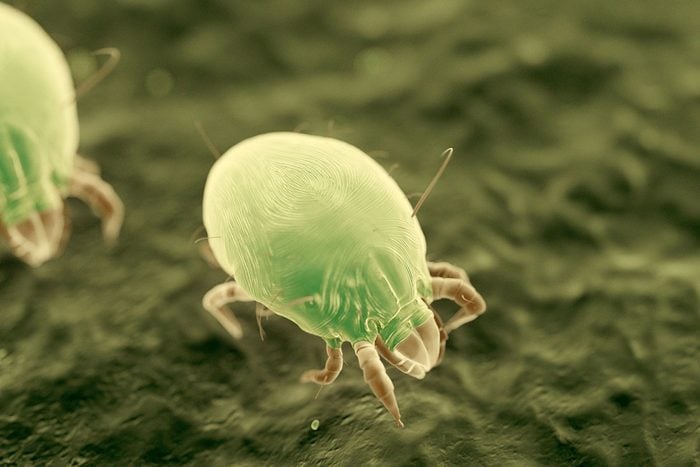Do Dust Mites Bite?
Updated: Apr. 15, 2024

Dust mites are inevitable and relatively harmless, but they can cause health problems. Find out what those problems are — and if mite bites are among them.
They are everywhere. Dust mites live in soft fabrics, bedding, furniture, blinds, curtains and anywhere dust can settle. They feed on the detritus of our daily lives, such as dead skin cells and pet dander. While they don’t actually bite, the Asthma and Allergy Foundation of America notes about 20 million Americans have an allergic sensitivity to dust mites.
Although you can’t get rid of them completely, dust mites can be easily managed so they don’t hold you hostage to nasal drip, a skin rash and the other bad reactions they cause.
On This Page
What Are Dust Mites?
Dust mites are spindly insects that feed off some of the 500 million tiny flakes of dead skin people shed daily. They have a small head, eight spider-like legs and a fat body — but no respiratory system or eyes. Dust mites grow to about 1/100-in. long and can only be viewed with a microscope.
You probably won’t realize you’re living with them unless you begin sneezing or itching. There are more than a dozen species of these primitive creatures, which are related to spiders, ticks and chiggers.
It can take two to five weeks for a mite egg to mature into an adult. An adult male dust mite lives for one to two months, and females for up to three months. Females can lay approximately 100 eggs within those 90 days.
Do Dust Mites Bite?
Although they look menacing, dust mites don’t have mouths, lips, teeth or tongue, and so lack the ability to feast on your skin. Instead, dust mites have an opening that scoops up dead skin flakes. Then they secrete a digestive enzyme that can break down this bit of food.
Allergies are often triggered not just by the presence of the dust and mites, but by their fecal matter and body parts from dead ones that haven’t been vacuumed or swept away.
Dangers of Dust Mites in the Home
Though they are relatively harmless to humans and natural in the home environment, dust mites can create health issues. These microscopic pests are one of the most common indoor allergens.
The problem: Mites’ teensy fecal pellets and their minuscule remains can irritate the membranes of the nose and throat when inhaled and trigger a sneezing fit. They can also cause asthma attacks, allergic reactions and hives when skin comes in contact with infested fabrics, according to the American Lung Association.
Signs of Dust Mites
You can’t see them with the naked eye, but where there’s dust, there are dust mites. Sneezing, headaches, runny noses and other physical signs may also alert you to a dust mite problem in your home.
How To Get Rid of Dust Mites
It’s not truly possible to remove all dust mites from your spaces. But if they’re causing problems, you can significantly reduce them.
- Vacuum and dust regularly. Couches, chairs and other furniture with soft fabrics should be vacuumed weekly and surfaces dusted daily or weekly.
- Target dusty spots. Damp-mop tiled or wood floors and scrub windowsills and moldings where dust mites gather. If a room is particularly dusty, scrub it down and air it out.
- Invest in a HEPA air purifier. A room air cleaner with a high-efficiency particulate air (HEPA) filter removes animal dander and dust from the air.
- Clean your bed. Beds are the most popular place for dust mites, according to The College of Agriculture, Food and Environment at the University of Kentucky. We spend a lot of time shedding dead skin cells there, leaving a buffet for hungry dust mites. Wash bedding in hot water (130 F minimum), the Mayo Clinic advises, and give the bedding a spin in a hot dryer for 15 minutes to kill them. You could also put your stuffed bedding items in the sun; the heat from direct sunlight kills dust mites, too. Vacuum the mattress and pillows before making the bed with fresh, clean sheets.
How To Prevent Dust Mites
Keeping dust at bay will keep the population of dust mites in your home down to a manageable number. Here are some tactics to help.
- Control warmth and humidity. Dust mites thrive when the room temperature is between 68 F and 77 F, with humidity levels above 70 percent. To make the space less hospitable, use a dehumidifier as needed and keep the temperature outside their comfort zone.
- Buy with mite-resistance in mind. Choose allergen-proof bed covers and washable stuffed toys.
- Control pet dander. Give pets a quick brush daily to slough off dead skin cells. Do your best to keep pets out of the bedroom, too. Bathe dogs as often as once a week, depending on the breed and your sensitivity to mites, according to the American Kennel Club.
- Clean regularly. Vacuum soft fabrics throughout the house once a week, from the couch to the curtains and carpets. Dust surfaces daily or weekly. Sweep floors regularly, too.
